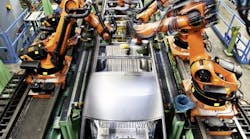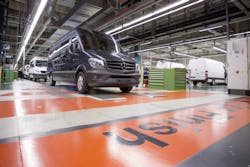As part of this week’s “ride-and-drive” event, the press got a peek inside the Dusseldorf factory that builds some 650 Sprinters and other assorted van models per day– some sporting the Volkswagen nameplate, as the result of a partnership Mercede-Benz (a division of Daimler AG) forged a while back with its erstwhile rival, along with the more familiar Freightliner logo.
While almost all the vans being built in Dusseldorf are tagged for the European light truck market – with the exception of the crew cab variety that gets exported to the U.S. – and though large- and medium-sized van sales in Western Europe dipped last year by 16%, the van itself is witnessing something of a renaissance in other countries around the globe, notably the U.S. and Canada.
Claus Tritt, general manager of commercial vehicles for Mercedes-Benz, noted that year-to-date sales of the Sprinter in the U.S. are up 11.7% and up 20.8% in Canada. Indeed, he pointed out at the ride and drive event here that commercial van sales are in both nations continue to increase at a healthy clip, moving from 190,766 units in 2010 to 250,989 units by 2012 in the U.S., with Canada seeing a bounce from 19,679 to 23,958 units over the same two-year period.
A lot of that may be due to changes in how traditional commercial work truck users view the van or yore, especially in terms of its use in the construction trades. Tritt noted, for example that 60% of the Sprinter vans Mercedes sells in the U.S. go into the construction trades, with delivery and passenger vans tied a very distant second at 15% a piece, while retail and wholesale configurations make up just 10% of Sprinter van orders in America.Yet seeing how Mercedes builds its Sprinter models in Dusseldorf – a production process no doubt reflected in its other plants in nearly Ludwegsfelde; Fouzhou, China; Charleston, S.C. in the U.S.; and soon Nizhny Novgorod in Russia by the end of 2013 – it’s not surprising that commercial buyers outside of Europe are taking more interest in the van’s potential for their operations.
For starters, Mercedes assembles its vans using robots much the same way heavy trucks are built in the U.S. and Europe, with key parts of the chassis and body (especially the engine hood and doors) given a zinc coating (along with 4 to 5 other coatings) to provide better resistance to the elements and tough workaday conditions.
Mercedes production experts noted that the constricted space afforded the Dusseldorf plant – it sits downtown almost right on top of the ancient city’s medieval roots – forced the company to expand vertically rather than horizontally, so the assembly lines snakes between two floors in the main three-story factory, with components built and fed into the line from another three story facility.
The Dusseldorf plant encompasses 70,000 square meters of total space and operates three shifts, with 800 personnel working on each shift and each shifting lasting 8 hours. Interestingly, none of the 650 Sprinters built in Dusseldorf are headed for inventory – they are all “sold” vehicles and 350 get shipped out of the plant every day to customers, Mercedes said.
It’s a fascinating process watching just how much detail and technology goes into crafting a modern-day commercial vehicle. For example, in the case of the Sprinter, some 18 robots are dedicated just to prepping and installing the van’s windshield (called a “windscreen” in Europe) with human hands only used to attach the rubber seal around the glass.
And several times per hour, two workers jump into what’s known as a “quality gate” near the end of the assembly line to put several randomly-selected finished vehicles a thorough visual inspection just to make sure everything is up to snuff.
It’s such attention to detail that enables OEMs like Mercedes-Benz and others in the truck world to produce products that last longer out in the harsh on- and off-road conditions where commercial customers ply their various trades. And the demands placed on commercial vehicles are only going to increase.





